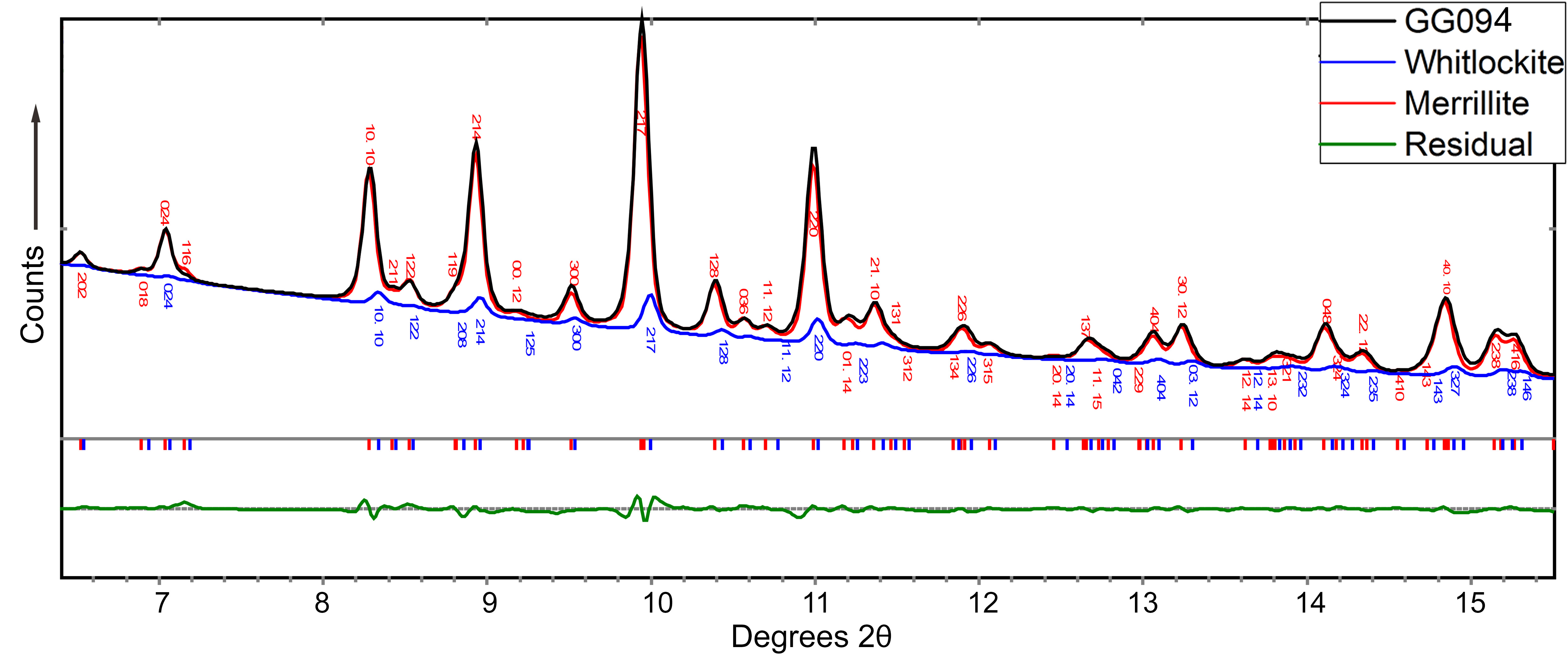Mars may have been a wetter place than previously thought, according to experiments on lab-synthesized mineral samples—proxies for Martian meteorites—performed in part at the ALS. The samples were subjected to levels of shock experienced by meteorites ejected from Mars, then measured for mineral content using x-ray microdiffraction. The studies showed that such shocks can cause merrillite, a mineral found in Martian meteorites, to be generated from a similar mineral, whitlockite, the presence of which would indicate a more water-rich history for the Red Planet. The results have broad implications for the interpretation of meteorite petrology as well as for astrobiology, highlighting the importance of transporting unshocked samples directly from Mars to Earth for a more accurate picture of ancient Martian geology.

Minerals in meteorites preserve evidence about topics such as the formation of the solar system and the potential for extraterrestrial habitability. Of particular interest in this work are the related phosphate-containing minerals, whitlockite and merrillite. Heating whitlockite to about 1000 °C dehydrogenates it (removes hydrogen), producing merrillite. In most Martian meteorites, merrillite is the dominant phosphate-containing mineral, suggesting that it may be the dominant primary phosphate phase on Mars as well. The prevalence of this anhydrous mineral has previously been interpreted as evidence of relatively dry Martian magmas. However, recent observations of other phosphate minerals in Martian meteorites suggest relatively high water content, raising the question as to why merrillite rather than whitlockite forms in a melt with available water at the time of phosphate crystallization.

The researchers hypothesized that, since Martian meteorites are the products of ejecta launched into space by asteroid impacts, they undergo temperatures and pressures sufficient to transform whitlockite to merrillite. To test this, the researchers synthesized whitlockite samples and performed shock-compression experiments on them. To simulate the severe impacts needed to accelerate material fast enough to escape the gravitational pull of Mars, the researchers blasted the synthetic whitlockite samples with metal plates fired from a gas-pressurized gun at speeds up to about 1,678 mph, at pressures of up to about 20 GPa. The pressures and temperatures generated in the shock experiments, while comparable to those of a meteorite impact, lasted for only about 10 µs, or about one-tenth to one-hundredth as long as an actual meteorite impact.
The researchers then studied the samples’ microscopic makeup with x-ray microdiffraction experiments at the Advanced Photon Source (APS) and ALS Beamline 12.2.2. The results showed that up to 36% of the whitlockite was transformed into merrillite at the site of the metal plate’s impact with the mineral and that shock-generated heating rather than compression may play the biggest role in whitlockite’s transformation into merrillite. Given that the experiments showed even partial conversion to merrillite in these lab-created conditions, a longer-duration impact would likely have produced almost full conversion to merrillite.
This is important for deducing how much water could have been on Mars in the past, and whether the water was from Mars itself as opposed to comets or meteorites. If even a part of the merrillite had previously been whitlockite, it changes the water budget of Mars dramatically. And because whitlockite can be dissolved in water and contains phosphorus, an essential element for life on Earth, the study could also have implications for the possibility of life on Mars.
The researchers are pursuing another round of studies with actual Martian meteorite samples, looking for any traces of water, using infrared light in addition to x-rays. However, although meteorites are, and continue to be, of immense value as samples of our solar system, the results of this study emphasize their shortcomings. The researchers note that, ultimately, directly transporting samples to Earth is the only path to obtaining samples unaltered by shock.

Contacts: Christopher Adcock and Oliver Tschauner
Research conducted by: C.T. Adcock, O. Tschauner, E.M. Hausrath, A. Udry, and M. Ren (University of Nevada, Las Vegas); S.N. Luo (Southwest Jiaotong University, China); Y. Cai (University of Science and Technology of China); A. Lanzirotti and M. Newville (University of Chicago); M. Kunz (ALS); and C. Lin (Carnegie Institution of Washington).
Research funding: National Aeronautics and Space Administration; National Science Foundation; University of Nevada, Las Vegas; U.S. Department of Energy (DOE), National Nuclear Security Administration; National Center for Scientific Research (France); 973 Project of China; National Natural Science Foundation (China); and DOE Office of Science, Basic Energy Sciences program (DOE BES). Operation of the ALS is supported by DOE BES.
Publication about this research: C.T. Adcock, O. Tschauner, E.M. Hausrath, A. Udry, S.N. Luo, Y. Cai, M. Ren, A. Lanzirotti, M. Newville, M. Kunz, and C. Lin, “Shock-transformation of whitlockite to merrillite and the implications for meteoritic phosphate,” Nat. Commun. 8, 14667 (2017). doi:10.1038/ncomms14667
Adapted from the Berkeley Lab news release, “New Evidence for a Water-Rich History on Mars.”
ALS SCIENCE HIGHLIGHT #354